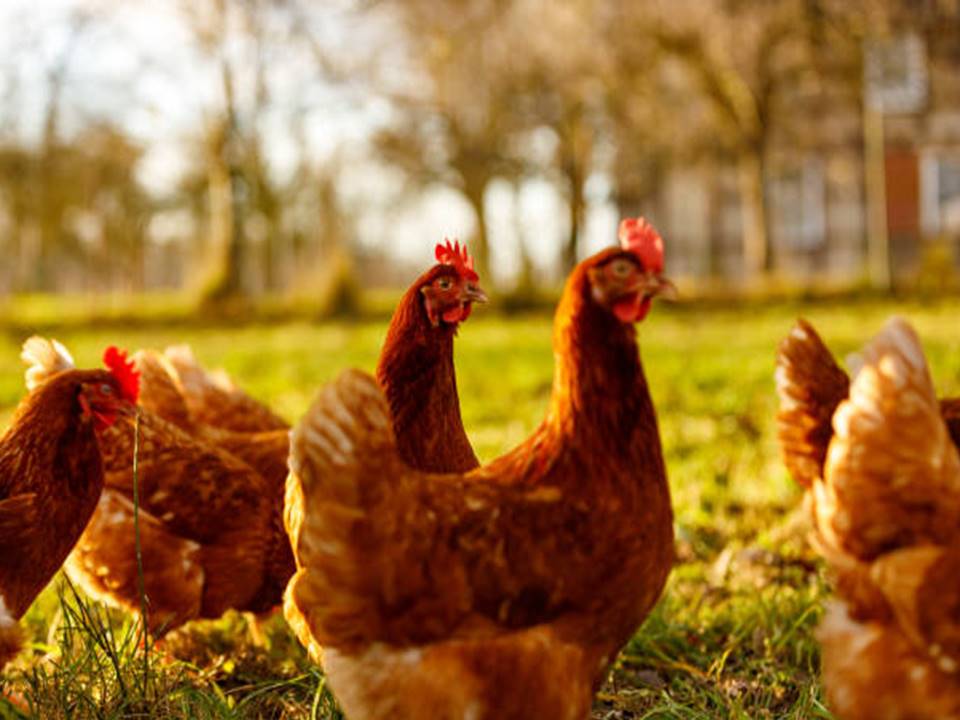- Introduction to Farm-to-Table Business
- Why Choose Farm-to-Table?
- 1. Planning Your Farm-to-Table Business
- 2. Sustainable Farm Practices for Long-Term Success
- 3. Building a Brand for Farm-to-Table
- 4. Direct Sales Channels for Customer Engagement
- 5. Effective Marketing Strategies for Farm-to-Table Success
- 6. Managing Legal, Health, and Safety Standards
- 7. Logistics and Distribution Strategies
- 8. Building Strong Community Engagement
Introduction to Farm-to-Table Business
The farm-to-table movement is reshaping how we source and consume food, emphasizing transparency, freshness, and sustainable practices. For organic chicken farmers like those at Green Feather Farming, a farm-to-table model connects directly with consumers who prioritize healthy, ethically produced products. This direct approach can reduce reliance on intermediaries, increase profitability, and build a loyal customer base while promoting environmentally friendly farming practices. This guide will walk you through the steps to establish a successful farm-to-table business, from planning and sustainable practices to branding and logistics.
Why Choose Farm-to-Table?
Farm-to-table is more than a business model; it’s a holistic approach to food production that builds trust with consumers. People are becoming increasingly aware of where their food comes from, favoring suppliers who practice ethical, sustainable farming. For farmers, this shift opens new opportunities to cater to niche markets interested in health, sustainability, and quality. Furthermore, farm-to-table offers better pricing control, as there are fewer intermediaries involved in the process, allowing farmers to retain a larger portion of their earnings.
Farmers can benefit from this model by reaching customers directly and educating them about the benefits of organic chicken, humane farming practices, and how fresh, natural foods contribute to a healthy lifestyle. This article will guide you through the necessary steps to develop a farm-to-table business while addressing challenges like certification, logistics, and customer engagement.
1. Planning Your Farm-to-Table Business
Setting Business Goals and Target Audience
Starting a farm-to-table business requires clear goals and a thorough understanding of your audience. Are you aiming to cater to local markets or to scale operations over time? Identifying the needs and preferences of your target audience—organic chicken farmers, sustainable agriculture enthusiasts, and those interested in small-scale farming—will help shape your approach.
- Audience Segmentation: Different segments may value various aspects of farm-to-table, from quality and freshness to sustainability. For instance, beginner farmers might prioritize guides on farming basics, while health-conscious buyers may value transparency in sourcing.
- Product Planning: Will you focus solely on fresh organic chicken and eggs, or diversify into products like organic compost or ready-to-cook meal kits? Starting with a focused product line, such as free-range eggs and pasture-raised chickens, helps establish your business identity. For those new to organic farming, our article Starting Your Own Organic Chicken Farm can be an excellent starting point.
Budgeting and Funding Options
Setting a realistic budget is crucial to understanding your costs, from feed and equipment to packaging and distribution. To secure initial capital, consider agricultural grants, farm-specific loans, or even community-supported agriculture (CSA) programs where customers buy shares in advance in return for regular product deliveries. Budget for operational expenses, marketing, and a reserve fund to handle unexpected costs.
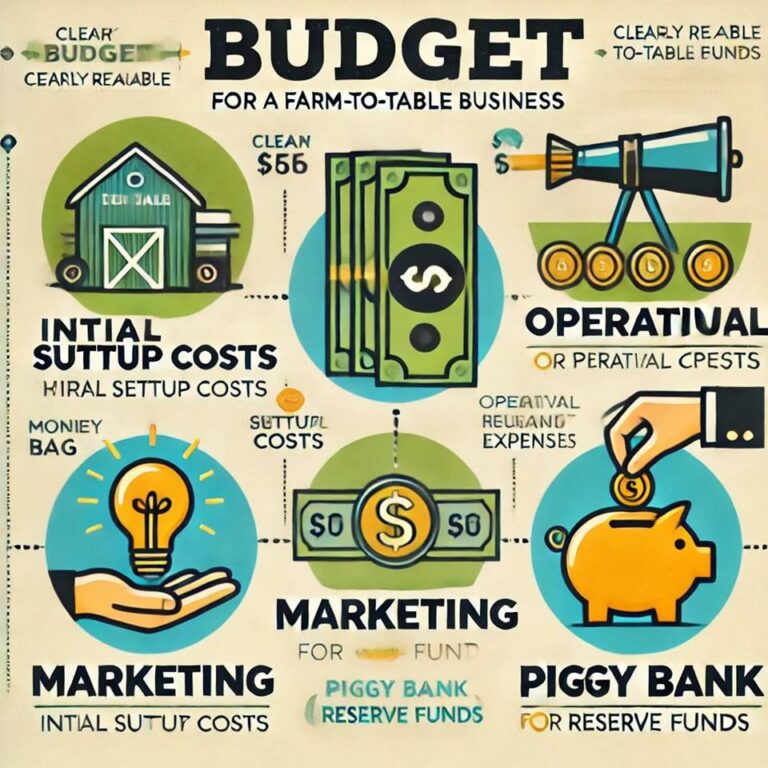
Infographic: Budget categories such as initial setup, marketing, and ongoing expenses.
Legal Considerations and Certifications
Compliance with local health and safety codes, including organic certification and pasture-raised verification, adds value to your products and assures customers of their quality. Obtaining these certifications may require time and investment, but they are worth the effort as they enhance your credibility and allow you to price products competitively.
Consider certifications that are recognized within your region and that align with your target market’s values. For example, consumers focused on health and animal welfare may look for USDA Organic or Certified Humane labels.
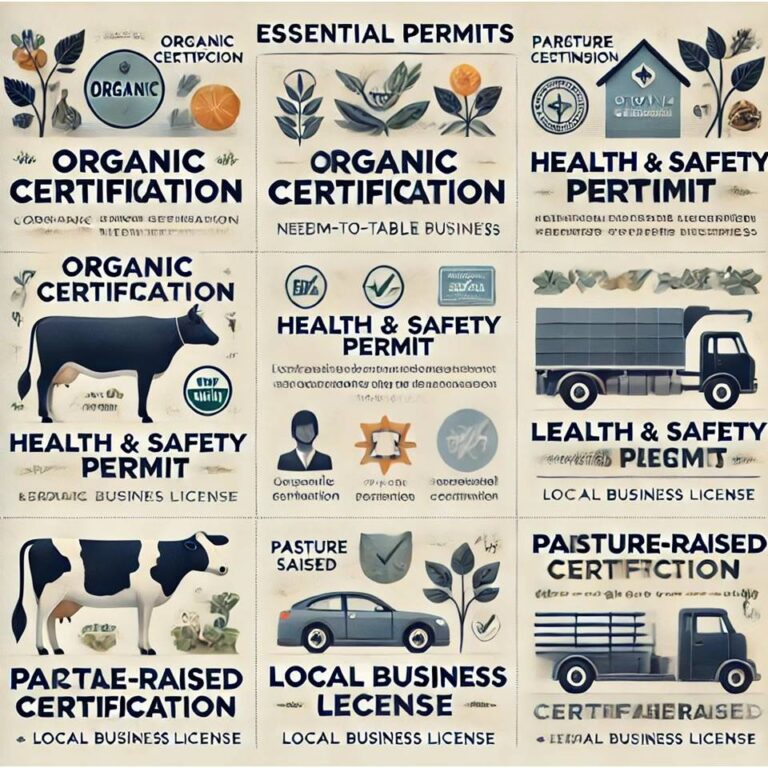
Checklist: of important certifications and licenses required for farm-to-table businesses.
2. Sustainable Farm Practices for Long-Term Success
Sustainability is the backbone of the farm-to-table movement, benefiting both the environment and consumers. Adopting sustainable methods ensures long-term productivity and appeals to customers who value environmentally friendly practices.
Organic and Pasture-Raised Farming Techniques
Organic practices like avoiding antibiotics, hormones, and synthetic pesticides benefit not only your chickens but also the ecosystem. Natural feeding methods, such as free-range foraging and organic supplements, improve the quality of chicken meat and eggs. Our guide Daily Routines for Healthy Chickens details practices that promote chicken health naturally, essential for maintaining organic standards.
- Rotational Grazing: Rotating chickens across different pastures improves soil health and helps manage parasites. This technique reduces the need for chemical treatments and enriches the diet of the chickens as they forage.
- Integrated Pest Management: Use natural pest control methods to manage common farm pests. Chickens naturally control insect populations, and planting herbs like mint or lavender around the farm can repel insects without chemicals.
Waste Management and Composting
Sustainable farms find ways to recycle waste, and chicken manure can be a powerful resource. Composting chicken manure not only manages waste but also creates nutrient-rich soil that can support crop growth, potentially adding another revenue stream if sold as organic fertilizer. By incorporating waste management practices, you contribute to soil health and a closed-loop farming system.
3. Building a Brand for Farm-to-Table
Branding is more than a logo or tagline; it’s the story and values that your business represents. In the farm-to-table market, consumers connect deeply with brands that convey authenticity, quality, and a commitment to sustainability.
Crafting a Compelling Story
Sharing your journey as a farmer and your dedication to sustainable practices helps build a bond with your customers. For instance, explain why you chose organic farming or how your chickens are raised in an open, natural environment. Stories about daily farm life, challenges overcome, or lessons learned can humanize your brand, making it relatable and memorable.
Logo, Packaging, and Design Choices
Design a logo that reflects the natural, organic quality of your farm. Using earthy colors, simple designs, and recyclable packaging materials reinforces your commitment to the environment and appeals to eco-conscious consumers. For example, compostable egg cartons or biodegradable labels enhance the eco-friendly perception of your products.
Digital Presence and Content Marketing
In today’s digital age, an online presence is essential. A professional website lets you showcase your products, share educational content, and facilitate online sales. Additionally, engaging in content marketing can position your brand as a trusted authority. Our post on Effective Marketing for Natural Chicken Products offers ideas for building a strong digital presence.
Use social media to regularly update customers on farm activities, product availability, and seasonal promotions. Platforms like Instagram allow you to connect visually, showcasing the farm-to-table experience through engaging photos and videos. Read more on USDA’s Sustainable Agriculture Research and Education (SARE) for further resources on sustainable farming practices.
4. Direct Sales Channels for Customer Engagement
A key advantage of farm-to-table businesses is direct access to customers. Selling directly allows you to form relationships, gain feedback, and build a loyal customer base. Here are some popular direct sales channels to consider:
Farmer’s Markets
Participating in local farmers’ markets is an effective way to engage with customers who are already interested in buying fresh, local food. At these markets, you can answer questions, share the benefits of your products, and offer samples. Farmer’s markets attract people who prioritize freshness, quality, and sustainability, making them an ideal venue for promoting your farm-to-table business.
Online Sales and Delivery
Setting up an online store with delivery options can help you reach a broader audience. Platforms like Shopify or WooCommerce allow you to list products, accept payments, and manage orders with ease. Offering local delivery or pick-up options can expand your customer base to busy individuals who may not have time to shop at markets. Many consumers also appreciate the convenience of home delivery, especially when ordering fresh, perishable items.
Subscription and CSA Programs
Community-supported agriculture (CSA) programs and subscription boxes offer a way to secure regular revenue while building community involvement. Customers prepay for a share of your farm’s produce, receiving weekly or monthly boxes of fresh goods. This model provides customers with variety and an ongoing connection to your farm, while the upfront payment helps manage cash flow.
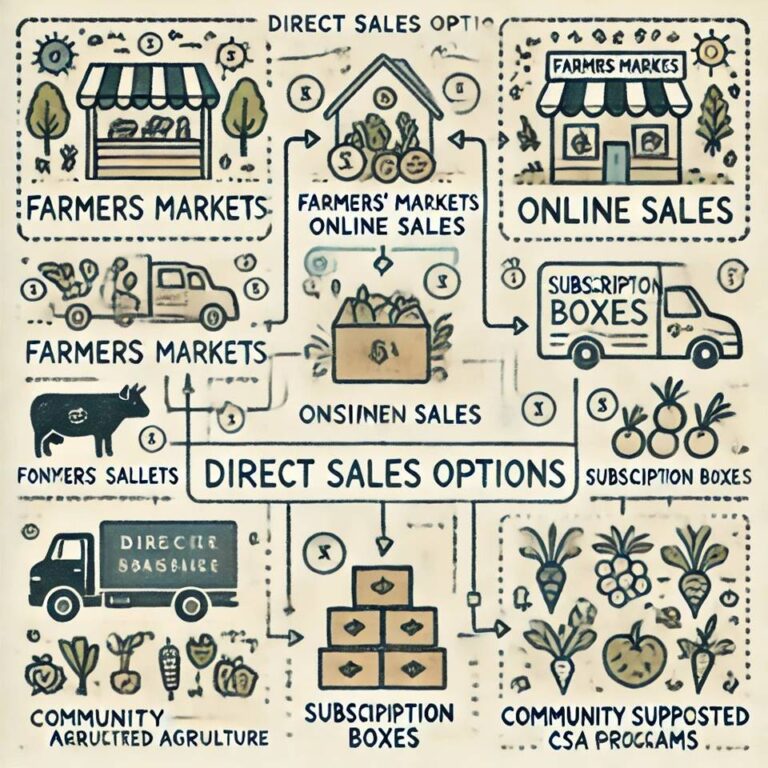
Flowchart: comparing various direct sales options like farmers’ markets, CSAs, and online sales for easy decision-making.
5. Effective Marketing Strategies for Farm-to-Table Success
Effective marketing is essential for spreading the word about your farm-to-table business and creating a loyal customer base. In a niche where authenticity and transparency are highly valued, content that educates and informs can go a long way.
Content Marketing for Engagement
Create informative blog posts, newsletters, and social media updates that share your knowledge about organic farming, animal welfare, and sustainable practices. This can include everything from educational articles on raising chickens naturally to recipe ideas featuring your products. For an example of educational content, check out our article An Overview of USA and EU Organic Chicken Farming Guidelines.
Educating your audience on topics like humane farming practices or the benefits of organic chicken can position you as an industry authority. People who appreciate your insights are more likely to support your farm, knowing they are buying from a knowledgeable and trustworthy source.
Social Media Strategy
Platforms like Instagram and Facebook are ideal for showcasing the daily life of your farm and your products. Social media enables you to post photos, videos, and updates that bring customers closer to your farm, showing transparency and building a sense of trust. For example, you can post a weekly update with images of the week’s harvest, a behind-the-scenes look at the farm, or spotlight particular products.
Using relevant hashtags like #organicfarming, #farmtotable, and #sustainablefood can increase the visibility of your posts, attracting new customers interested in sustainable farming.
Email Newsletters for Loyalty
Build an email list for customers interested in regular updates. Newsletters allow you to notify your audience about product availability, upcoming farm events, and exclusive offers. They can also include educational content, recipes, and tips, keeping your audience engaged and informed. A popular study Edible Communities, a network that supports local food systems and sustainable agriculture.
6. Managing Legal, Health, and Safety Standards
Ensuring compliance with health and safety standards is vital in any farm-to-table business. Meeting these standards not only keeps your operations running smoothly but also builds customer trust, as consumers are increasingly concerned about food safety.
Understanding Local Health Regulations
Health regulations vary widely by region, so it’s crucial to familiarize yourself with local requirements. These may cover everything from hygiene standards and food storage to animal welfare. For example, you may be required to keep chickens in sanitary conditions, store eggs at specific temperatures, and use approved methods for handling and processing meat.
By staying compliant, you protect both your customers and your business. Additionally, understanding these regulations from the outset helps avoid fines and potential closures.
Obtaining Certifications and Permits
Obtaining organic and pasture-raised certifications adds value to your products by assuring consumers of your commitment to quality. Certifications like USDA Organic or Certified Humane are often recognized by customers and serve as a testament to your ethical and sustainable practices. Additionally, certain permits may be required for selling directly to consumers, especially if your products are prepared or processed on-site.
Maintaining accurate records is essential to streamline the certification process and provide documentation during inspections. Keep detailed records of feed sources, flock health, and farm practices to ensure compliance.
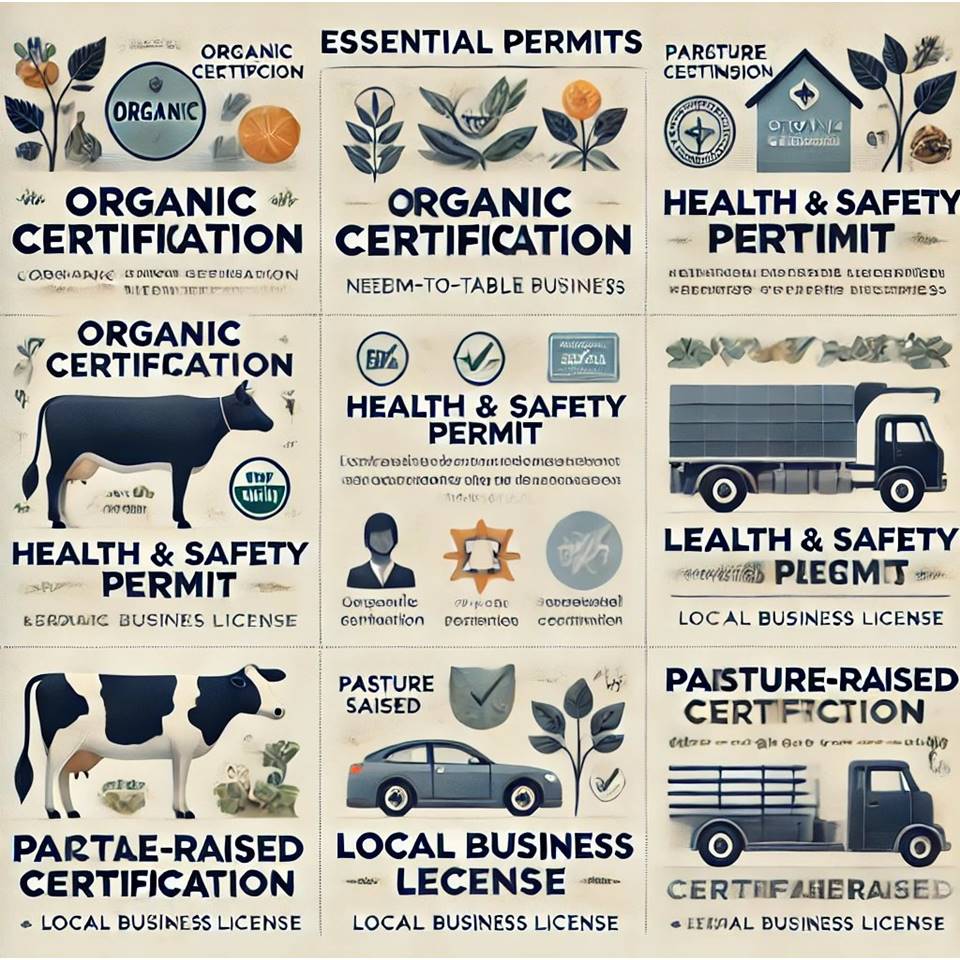
Checklist: Infographic covering necessary permits and certifications for organic poultry farms.
7. Logistics and Distribution Strategies
Effective logistics are essential for delivering fresh, high-quality products to customers. The logistics involved in a farm-to-table business often require careful planning to ensure freshness, minimize waste, and maintain efficiency.
Choosing the Right Delivery Methods
Depending on your target market, different delivery options may be suitable. Local deliveries allow you to reach nearby consumers quickly and ensure your products stay fresh. Consider partnering with local delivery services to offer eco-friendly options that align with your sustainability values.
For wider distribution, work with co-ops or distribution networks that prioritize small-scale farms. These partnerships can help expand your reach while preserving the farm-to-table ethos.
Sustainable Packaging Choices
Sustainable packaging is essential for an environmentally-friendly farm-to-table business. Opt for packaging that is biodegradable, compostable, or recyclable to minimize waste and appeal to eco-conscious consumers. For example, using compostable trays or cartons for eggs and recyclable bags for other products can demonstrate your commitment to sustainability.
Proper packaging also preserves product freshness and safety during transit. Invest in insulation options if needed, especially for products that are temperature-sensitive.
Streamlining the Supply Chain
From production to final delivery, an organized supply chain can optimize your operations, reduce costs, and ensure quality. Inventory management software can help track product availability, expiration dates, and delivery schedules, reducing waste and enhancing efficiency.

Interactive map: Local delivery routes to visualize sustainable logistics strategies.
8. Building Strong Community Engagement
Farm-to-table businesses thrive on community support. Building meaningful connections with customers fosters loyalty, strengthens your brand, and enhances the overall consumer experience.
Hosting Farm Events
Inviting customers to visit your farm can build trust and provide insight into your sustainable practices. Farm tours, seasonal events, and workshops allow customers to see firsthand how their food is produced, creating an authentic connection. For example, hosting a farm-to-table dinner or an open house where guests can experience the farm environment and sample your products helps build a loyal customer base.
Events also serve as excellent marketing opportunities, as attendees are likely to share their experiences on social media, increasing your brand’s visibility.
Offering Educational Workshops
Hosting workshops on topics like sustainable farming, organic chicken care, or healthy cooking with fresh ingredients can provide value to your community. These workshops can be held in partnership with local chefs, nutritionists, or food bloggers, broadening your reach and bringing additional expertise to the table.
Educational content strengthens community ties, as customers appreciate businesses that contribute to their knowledge and well-being. Additionally, offering classes can attract customers interested in sustainability and organic food. You can enhance konwledge by reading What good to eat, can dive more into how much protein do you need or further study on healthy breakfast ideas.
Collaborating with Local Businesses
Form partnerships with local restaurants, cafes, or specialty stores that align with your values. Featuring your products on local restaurant menus or offering exclusive products through select retail locations can boost brand visibility and reputation.
Collaborations with local chefs, in particular, can help introduce your products to a wider audience. For example, a restaurant could create a signature dish featuring your pasture-raised chicken, showcasing the quality of your farm-to-table produce.
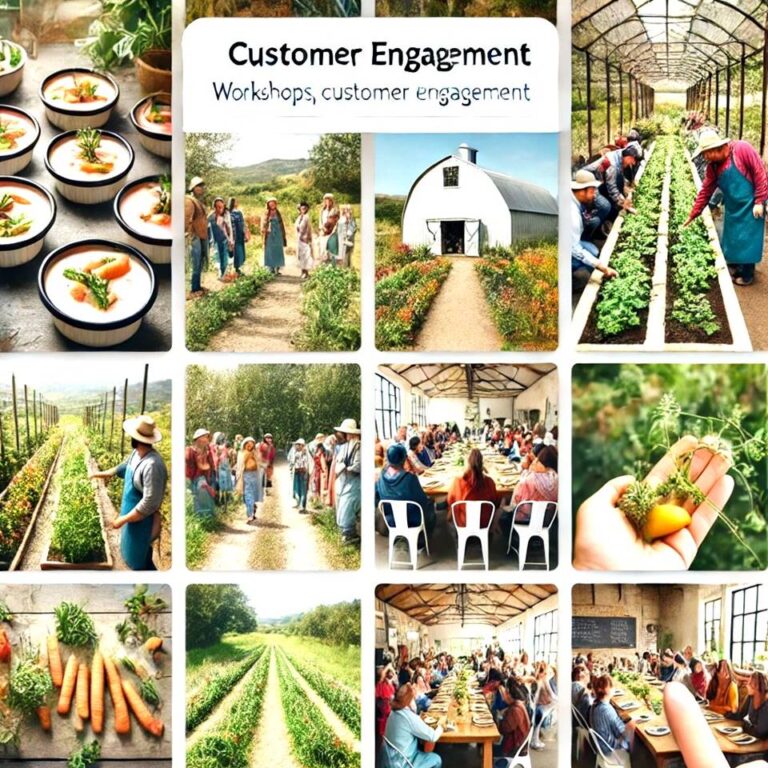
Carousel: Style layout of farm event photos


